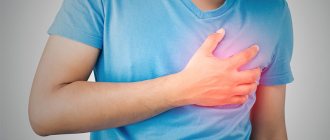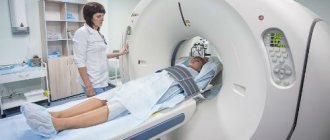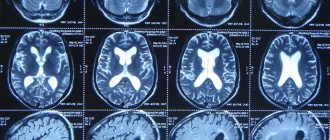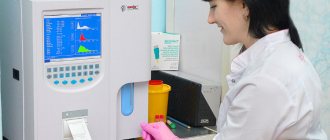Osteochondrosis is a very dangerous disease. It occurs unnoticed, and from mild uncomfortable sensations develops into serious disorders of the spine, which sometimes result in disability.
This disease is treated by therapists, neurologists, orthopedists, vertebrologists and other specialists at the Yusupov Hospital.
Location (irradiation)
To accurately understand this point, it is worth remembering human anatomy. The heart is located directly behind the sternum and there is an opinion that it should only hurt there. But the heart, like any other organ, receives innervation through the autonomic nervous system. Thus, from the epicenter - the heart - pain spreads through the autonomic nerve plexuses to the area of the left arm, left side of the back, neck, and chest.
Localization of pain during angina pectoris
The occurrence of osteochondrosis is caused by wear and tear of the articular elements. If the thoracic spine is affected, the pain often resembles that of angina pectoris. With osteochondrosis, irradiation can be both to the left and to the right side of the body.
Prevention
Since preventing the disease is much easier than treating it, preventive measures against the occurrence of osteochondrosis are relevant for almost every person over thirty. The main thing is to lead an active life, not experience excessive abnormal stress, and exercise in a balanced manner. Sudden movements, a static sitting position, lifting weights with a jerk - all this can provoke osteochondrosis.
An active lifestyle will help maintain spinal health into old age.
A healthy diet will also help prevent degenerative changes. The occurrence of cervicothoracic osteochondrosis can be promoted by high-calorie food, its excess, plus lack of activity. If you take care of your health, engage in moderately active sports, and perform preventive exercises, your body will be able to resist osteochondrosis on its own, and the disease will not overtake you.
Factors that provoke pain
In heart disease, emotional stress plays a key role. Against a background of stress:
- pain increases;
- the number of attacks increases;
- the duration of the pain syndrome increases;
- there is a risk of developing myocardial infarction;
- If medical care is not given in a timely manner, death is possible.
Physical activity also provokes heart pain. The more seriously the disease progresses, the less stress will cause discomfort. In severe stages of the disease, even climbing a few steps is dangerous.
With osteochondrosis, physical activity can also increase pain. The difference is that if a person lies down and takes a comfortable position, the pain will gradually decrease.
Heart pain is often triggered by physical activity
Osteochondrosis in adults: symptoms, causes, treatment
Treatment of osteochondrosis in general includes the following measures:
- physiotherapy courses;
- taking medications;
- different types of massage;
- reflexology;
- traction;
- manual therapy;
- physical therapy (physical therapy).
Taking medications
Treatment of osteochondrosis is carried out using drugs from different groups. Basic medications prescribed by a doctor:
- non-steroidal anti-inflammatory drugs. Their goal is to eliminate inflammation and relieve symptoms of osteochondrosis. In mild cases they are prescribed in the form of tablets, in severe cases - in injections. Used in a course of 7-14 days. Additionally, they can be used in the form of ointments;
- glucocorticosteroids. Used in more severe cases. Injected in the form of injections directly into the painful area;
- muscle relaxants. Temporarily reduce muscle tension, relieving pain and inflammation. Prescribed both in the acute period and during remission;
- B vitamins. Useful for improving nerve conduction in the spine;
- chondoprotectors. Help improve nutrition of intervertebral cartilage, strengthen discs;
- vascular drugs. Improves blood supply to the spine.
Massotherapy
For osteochondrosis, it is necessary to undergo a course of therapeutic massage 2 times a year. It helps relieve muscle tension, eliminate tension, and improve blood supply to tissues. Massage is allowed only during the remission stage. It has a positive effect on the nervous system and increases the body's resistance to diseases.
Traction
Traction is a procedure for artificially stretching the spine using special equipment and simulators. As a result, it is possible to achieve an even distribution of vertebrae along the entire length of the spine. This way, excessive tension at the site of inflammation subsides, and pain goes away, as pinched vessels and nerves are released.
Manual therapy
The goal of manual therapy is to correct spinal curvature. The technique is based on a physical targeted effect on the human musculoskeletal system. This helps improve blood and lymph circulation, which helps improve mobility of the musculoskeletal system.
Physiotherapy
Treatment of cervical osteochondrosis using physiotherapy methods is practiced during the period of remission of the disease. The procedures are aimed at reducing symptoms and increasing the effect of medications taken. Most often, ultrasound, low frequency currents, laser and magnetic vibrations are used for osteochondrosis.
Reflexology
The essence of reflexology is the correct impact on pain points and reflex zones. The technique is not used independently, only in combination with massage, since this way a more significant effect is observed. With the help of reflexology, it is possible to relieve pain and restore the natural load on the spine.
Physiotherapy
Exercises for osteochondrosis are an integral part of the treatment of the disease, regardless of the affected area. Dosed loads on joints and muscles help strengthen the muscular corset of the back, make it more flexible and improve overall well-being. Physical therapy exercises should take place outside the acute stage of the disease, when severe pain has been relieved, otherwise the condition may only worsen.
Basic methods of exercise therapy:
- mechanotherapy – performing exercises on special simulators and devices. This technique is used when there are difficulties in movement against the background of a serious degree of damage to the spine;
- kinesitherapy is a combination of physical exercises and breathing exercises. The complex is developed for a specific patient;
- health path – walking with a set of simple exercises that improve the functions of the respiratory and cardiovascular systems;
- Therapeutic swimming is one of the best forms of exercise for osteochondrosis. Helps in developing correct posture and returning the shoulder position to its natural appearance.
Home remedies
To treat osteochondrosis at home, you must first consult with your doctor. Traditional treatment mainly consists of using various ointments and drinking herbal infusions, as well as using rubs. Home remedies for the treatment of osteochondrosis can be used:
- cinquefoil tincture. You need to rub it on the sore spot, then tie a warm scarf or wrap yourself in a blanket. Additionally, you can take the tincture orally - a couple of drops every day before bed;
- ointment. Mix 1 tbsp. vinegar with 1 tbsp. flour, 100 g butter and egg. Leave the mixture in a dark place for 2 days. Then mix thoroughly and rub into the sore spot;
- radish tinctures. To 300 ml of juice of this vegetable add 100 ml of vodka and 200 g of honey. Rub the resulting mixture onto the sore area every day before bed until pain is eliminated.
Instrumental studies
During periods of acute pain, it is best to seek medical help. In particular, this will certainly help to make a differential diagnosis between osteochondrosis and heart disease.
ECG
When recording a cardiogram, cardiac pathology will be immediately determined. If the ECG is normal, then most likely the cause of the pain is osteochondrosis or neuralgia.
ECG is a mandatory method of examination when chest pain occurs.
Ultrasound
This study can be performed in those patients who are suspected of having an infectious lesion of the heart (carditis of various etiologies). Used only as an additional method.
Radiography
X-ray is indicated for everyone who is suspected of having osteochondrosis. The photographs will show destructive changes in the joints. In case of heart disease, the articular surfaces will be normal.
CT and MRI
Performed when radiography is ineffective. And also to identify a clearer localization of the lesion. Using MRI, you can diagnose both cardiac pathology and osteochondrosis. But a heart attack is an emergency condition that requires urgent drug therapy, and an MRI is a rather lengthy procedure.
Two “markers” of osteochondrosis: dorsago and dorsalgia
One of the most striking manifestations of the disease. Dorsago is also called thoracic lumbago. This is a shooting pain in the chest that occurs suddenly, especially after being in one position for a long time. The sensation makes it difficult for a person to breathe. If you try to turn your torso to the side, the pain will intensify.
Dorsalgia, on the contrary, is characterized by mild pain. Localized at the site of the affected intervertebral disc. It is more dull in nature and differs in duration (2-3 weeks). When you take deep breaths and bend over, the pain intensifies. If you walk for a short time, the pain goes away. At night they intensify.
Effect of drugs
Most people over 50 have a whole arsenal of medicines at home. And among them there will definitely be remedies for high blood pressure and nitroglycerin.
In case of an acute attack of chest pain, taking nitroglycerin under the tongue is justified. If the pain was of a cardiac nature, it will decrease or disappear completely. After this, you still need to consult a doctor to rule out complications.
If the pain arises from osteochondrosis, then nitroglycerin will not have any effect.
Nitroglycerin will reduce the intensity of pain during an attack of angina pectoris
Concomitant pathology
Diseases in which there is a high probability of attacks of pain in the heart:
- Arterial hypertension. Leads to changes in blood vessels, including the vessels that supply the heart muscle.
- Angina. The same pathogen infects the tonsils in the throat and causes the development of endocarditis. Heart damage can be a serious complication of tonsillitis.
- Thrombophlebitis. It can provoke blockage of a vessel of any location, including the heart.
If a diagnosis of angina is made, then the pain occurs precisely because of heart problems. But it may happen that one person develops osteochondrosis and angina. In this case, the person himself can distinguish between 2 types of pain and the source of origin.
Methods for diagnosing osteochondrosis of the thoracic spine
To undergo a comprehensive examination, you need to see a neurologist. He will collect anamnesis, clarify complaints, conduct a thorough examination of the patient, and select diagnostic methods. The range of studies depends on the patient’s age, the presence of chronic diseases, the severity of the pain syndrome and other features. Usually prescribed: MRI, CT, radiography.
To exclude other diseases accompanied by similar symptoms, the following may be performed: ultrasound, ECG, echocardiography, EEG, clinical urine and blood tests, consultations with specialists.
Age
Osteochondrosis develops with age. Gradually, a person begins to hurt a joint (one or more) and over time the disease progresses, especially without treatment.
Heart disease, unfortunately, can occur at any age. Even heart attack, angina pectoris and arterial hypertension have recently become younger. They can develop as early as 30 years of age.
Pain that appears repeatedly, is intense, requires control and supervision of a specialist. Therefore, even after coping with an attack, it is necessary to consult a therapist and undergo a full examination.
Nutrition rules
Proper nutrition during treatment of thoracic osteochondrosis is the lion's share of success. It is necessary to eat foods that contain substances necessary for the body at this time. For example, jellied meat, jelly and other dishes with gelatin help cartilage tissue to recover, as they contain chondoprotectors.
The abundance of protein is also important. Dairy products, meat and fish are animal sources of protein. Legumes (especially beans), nuts, seeds, eggplants and other vegetables are vegetable. Also, fresh fruits and vegetables are very useful for the proper functioning of the immune system and strengthening the body as a whole. Eating greens, broccoli, and celery will have a positive effect on treatment.
Dishes must be steamed or boiled.
Instead of bread made from white flour, you should choose whole grain, rye, or replace them with bread.
One of the main microelements necessary for the treatment of osteochondrosis is calcium, found in dairy products, almonds, greens and rose hips. Sunflower seeds, nuts, avocados and other magnesium-rich foods are essential in your daily diet. You should avoid concentrated broths, salted and smoked foods. An abundance of flour, sugar and seasonings is harmful, and preservation is also unacceptable.








